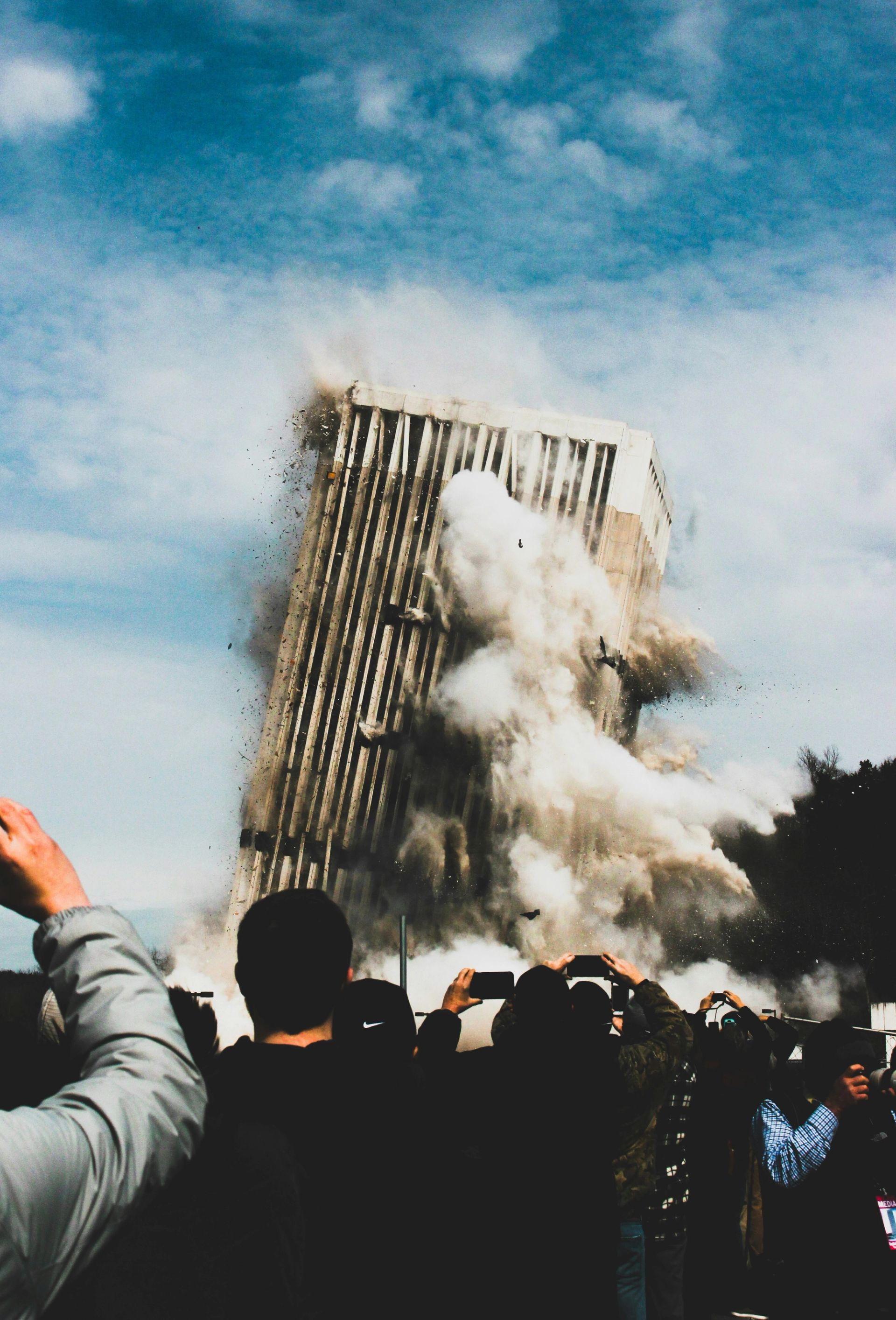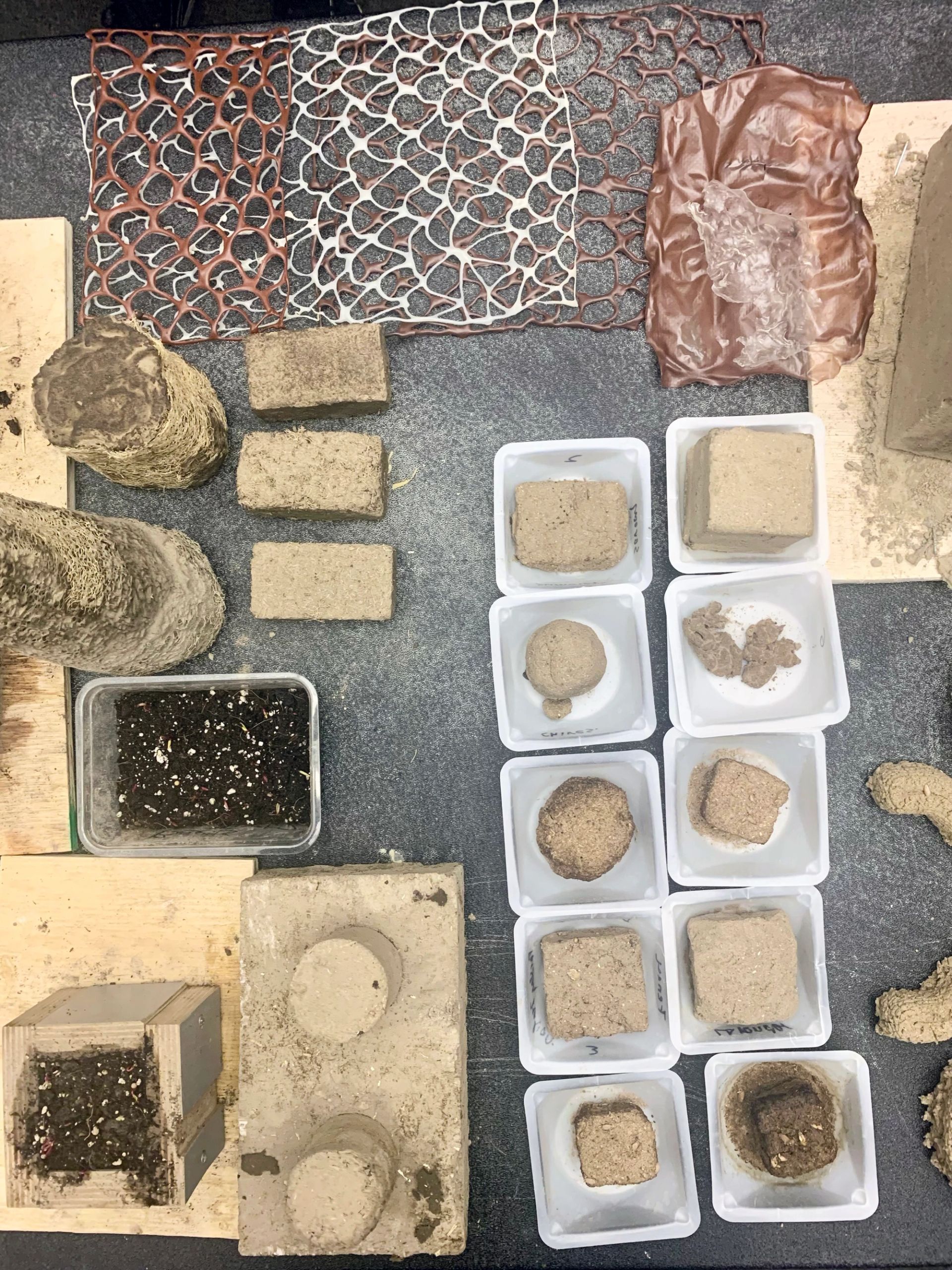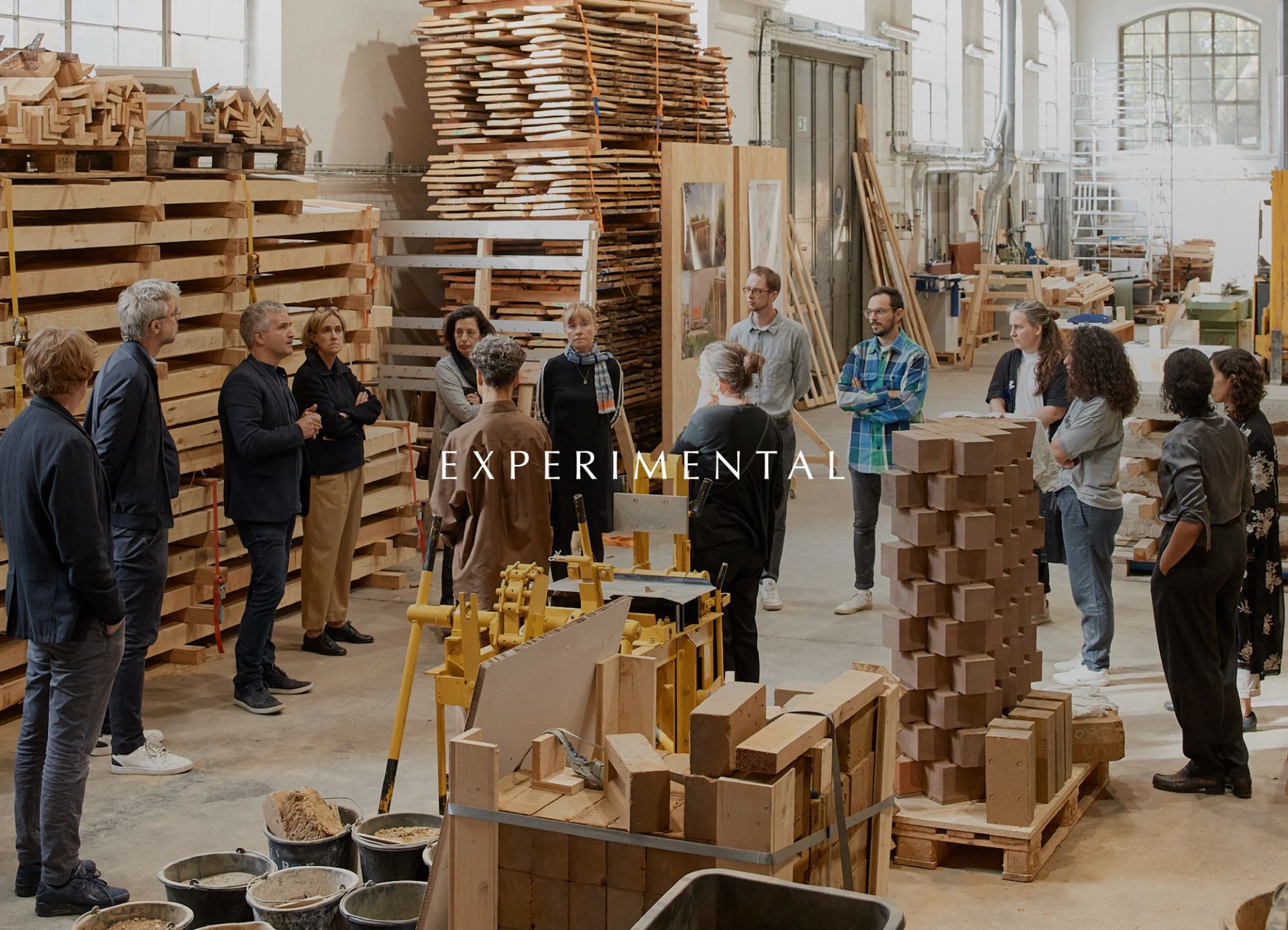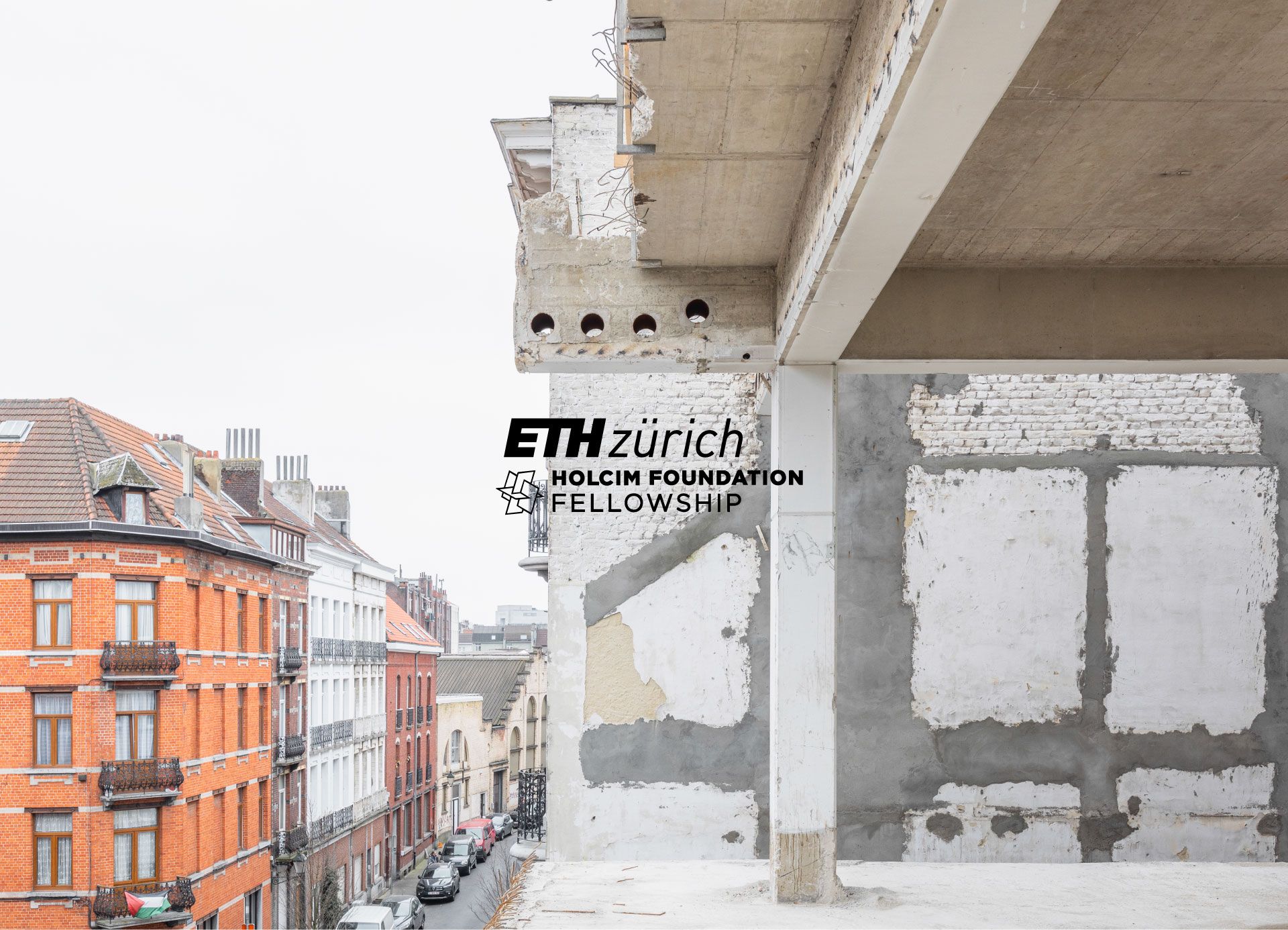Before and distinct from processes of recycling and reuse comes disassembly. In this essay, curator and researcher Zofia Trafas White expounds on and provides examples of the political agencies of deconstruction and de-composition, as factors to consider in sustainable design.
The essay ‘Disassembling: In search of models’ is excerpted from the exhibition catalogue ‘Material Acts: Experimentation in Architecture and Design’ (Craft Contemporary, 2025), edited by Kate Chiu Yeh and Jia Yi Gu. This essay is published as an integration to the conversation with Jia and Kate on the homonymous exhibition.
A messy context
The explosions that demolished the Pruitt-Igoe building were loud and messy. The series of planned demolitions that began in St. Louis, Missouri, on March 16, 1972, had been initiated by state and federal governments following rising concerns around the deteriorating conditions of the public housing complex, originally built under a regime of New-Deal optimism in urban renewal and centralised planning by renowned modernist architect Minoru Yamasaki. Meticulously planned and controlled, each explosion of the steel-and-concrete building produced a spectacle visible from afar, with dust from the rubble rising high into the sky. With a demolition cost of $3.5 million, it was the first major public housing project in the USA to be destroyed.1 Televised and widely debated at the time, the demolition event became symbolic of Modernism’s end to many social critics and observers in the architecture community.2
Viewed through an environmental lens, the televised 1972 Pruitt-Igoe demolition is a poignant reminder of the ubiquitous practice of dismantling buildings by brute force. Built environments of bricks, mortar, concrete, and glass are not designed to be easily taken apart. Whether by dynamite, wrecking ball, or sledgehammer, most processes to this day rely on crude methods that don’t often leave much for re-use. And demolition itself continues to fascinate: YouTube alone contains over four million clips capturing building demolitions all around the world, while television documentary series like Blowdown (2008) appear to almost glorify their ingenuity.
"Viewed through an environmental lens, the televised 1972 Pruitt-Igoe demolition is a poignant reminder of the ubiquitous practice of dismantling buildings by brute force."
Widespread across the globe, demolition practices today contribute to pressing concerns about the wasteful and damaging environmental impact of buildings. In the context of a growing planetary climate crisis, finding new, more sustainable models of practice that rethink building material lifespans has never been more urgent.
Today’s construction industry is a staggering consumer of the world’s depleting material resources. Globally each year, nearly half of the materials extracted and manufactured are used for the construction of buildings and infrastructure, much of which, decades after initial use, ends up as a waste.3 While such patterns continue, materials consumption is only set to rise, with projections that the usage of materials for building projects will double by 2060 across the world.4 Such turnover of materials mirrors statistics around carbon emissions that warm the climate. As highlighted by architectural historian Barnabas Calder, the construction, operation, and demolition of buildings today are responsible for 39 percent of all greenhouse gas emissions.5
The management of carbon in architecture thus spans from the initial design process where materials and their methods of assembly are chosen to the wider systems that look after a building when it is occupied and when it is not. Such processes often fail, however, to plan for the reuse or safe disassembling of a building’s components. Across Europe, for example, building waste accounts for approximately 35 percent of total waste generated each year and consists of numerous material types, including concrete, bricks, gypsum, tiles, ceramics, wood, glass, metals, plastic, solvents, asbestos, and excavated soil, most of which ends up in landfills where ongoing deterioration can carry further polluting effects.6 Useful parts are rarely recovered, and that which is not discarded tends to be downcycled into lower quality product, such as filler for roadbeds or the foundations of new buildings. Rules and regulations, which vary from country to country, around who owns and manages the materials being removed from building sites add further complexity to this picture. Architects campaigning for action in the face of the climate crisis are calling for greater transparency in monitoring the embodied carbon footprint of buildings and greater regulation in the management of demolition building waste.7
Designers and manufacturers are also investigating the realities of spiraling building waste through material innovations. For instance, the K-Briq, which is developed by Scottish brick manu facturer Kenoteq Ltd., is made of 90 percent recycled construction waste and uses a low-energy curing process to bond the aggregate material in a formwork, without the need for traditional firing processes. The K-Briq initiative began in 2019 as a research project at Heriot-Watt University in Edinburgh and became a reality only through a successful collaboration with Scotland’s biggest waste management company Hamilton Waste & Recycling, who provided gypsum. Following initial testing and accreditation phases, it was released as a commercial product in the UK in Spring 2023 with hopes for wider industry impact.
While such innovations represent some positive steps forward, they are rare and limited as the architecture industry remains stagnant in a system of waste production. Bound up in capitalist economic models of growth, most current construction industry models justify demolishing and building new buildings, opting for cheaper materials over longevity and recycling potential. With such powerful economic forces at play, models of architectural design and fabrication, alongside the building codes that regulate them, need to be rethought in order to make sustainable material flows a norm.

Capital Plaza Tower. Frankfort, United States. Courtesy of Micah Williams and Unsplash license.
How we take things apart
How things are produced and what materials they are made from can play a defining role in the longevity of a design or how quickly it ends up discarded as waste. From single-use coffee cups to electronics, clothes, furniture, and buildings, waste is a complex force encompassing varied lifespans shaped by a network of actors and interests. It is also a deeply problematic concept that has the potential to be designed out. To do so requires models that rethink fundamental systems that govern how our designed world is made. In this context, disassembling offers an important framework for critically rethinking waste.
"From single-use coffee cups to electronics, clothes, furniture, and buildings, waste is a complex force encompassing varied lifespans shaped by a network of actors and interests."
Defined as “the action or process of taking something to pieces,” the modern usage of the term disassembling in the English language has its origins in military contexts.8 Around 1872, disassembling was originally used to describe the process of the systematic dismantling of mechanical objects such as small arms. Definitions at the time allude to the speed that such disassembling can happen, time being a critical factor for gun reloading and repairs. Such origins of the term connect to a wider historical moment of the Industrial Revolution when new inventions in mass manufacturing were changing the way machine-produced products were being designed. Military products, such as the American Colt Army Model 1860 revolver became game-changing inventions that perfected the mass production of identical, interchangeable parts. The Colt’s design answered calls from a wartime military industry that was struggling with the costs of made-to-order arms that were full of bespoke, hand-crafted parts, time-consuming, and expensive to fix. Innovations in gun designs with interchangeable parts made replacing parts a norm, while also perfecting technologies and precision machinery for the reliable production of identical parts (as was necessary for reliable military provision). Such principles of parts-based manufacturing then expanded into other factory-made designs for the civilian sphere such as sewing machines, bicycles, and eventually, cars.
Disassembling thus signals a planned process in which component pieces are capable of being joined together and taken apart, and when required, easily replaced. Crucial in the concept of disassembling are “parts.” Pre-designed from the outset, they operate as distinguishable, replaceable, and re-useable elements. Beyond the context of precision manufacturing, thinking through parts highlights an important principle of planning for dismantling and the possibility of recovery and re-use of materials. As such, disassembling invites long-term thinking into the process of design. Unlike the pulverised fragments that remain after a messy demolition, parts and reversible material assemblies help to reduce what becomes “waste” in the first place.
"Disassembling invites long-term thinking into the process of design. Unlike the pulverised fragments that remain after a messy demolition, parts and reversible material assemblies help to reduce what becomes “waste” in the first place."
Thinking about design as a practice of assembling and disassembling recoverable parts invites important connections to the systems of material flows found in the natural world. Here, there is no such thing as waste, as nature operates according to a system of nutrients and metabolisms that create a constant flow of resources. Described as a “cradle to cradle” system by architect William McDonough and chemist Michael Braungart in their eponymous book, the natural world runs as a circular system where “waste equals food” and a network of living species continuously feeds one another.9 This, they argue, sits in direct opposition to dominant cycles of human production that operate on linear “cradle to grave” models, in which materials are “thrown away.”
Drawing on this analysis of natural resource flows, McDonough and Braungart issue a rallying call for remaking the way we make things. Their approach is rooted in biomimicry, a practice that seeks to mimic systems found in the natural world in human designs. In their conception, design should operate on the premise that everything is a resource for something else. They propose two categories of materials, acknowledging that both natural and human-made materials circulate in our world. They argue that through the right material choices, everything has the potential to be designed to be disassembled: either safely returned to the soil as “biological nutrients” through decomposition, or re-utilised as high-quality materials for new products as “technical nutrients” without contamination.10
The looming crisis of microplastic pollution serves as a cautionary tale of what happens when this doesn’t happen, when the disassembly and disintegration of materials is unplanned.11 Since their early history as lab experiments in the nineteenth century, plastics have shown signs of instability and unpredictability as a material.12 Today, there is growing evidence of the far-reaching environmental and health damages caused by plastic breakdown, with safe methods for their dismantlement yet to be found.13 Designing for disassembling requires taking responsibility for material selection and having foresight of the human and non human forces that will ultimately act on them. From designing new materials to choosing from existing ones, cross-disciplinary knowledge across design and science is needed to responsibly model the full lifecycle of materials, and ensure that once released into the world, they won’t have unplanned, damaging forms of coming apart.
"Designing for disassembling requires taking responsibility for material selection and having foresight of the human and non human forces that will ultimately act on them."
Harvesting
Disassembling can operate as an intervention into structures slated for demolition. Here, design practices intervene to find and create parts for re-use, even if they have not been pre-planned. The result captures materials before they are disposed of as “waste,” prolonging their life as a useful resource. The work of Dutch architecture practice Superuse Studios demonstrates how interventions of disassembling and materials salvage can be drivers of design itself. Since its founding in 1997 by Jan Jongert and Césare Peeren, the studio has been committed to exploring the flows of materials in urban environments and finding ways to maximise their reuse. Today it operates as a collective based in various cities, each member helping instigate strategies for reuse interventions. “Recognizing opportunities are basic capabilities for what may become a new profession: the superuse scout,” says Jongert.14 The “superuse” method sees all buildings through the lens of the component parts they are originally made of, and views disassembling as a tool for extracting these parts for re-use. For the studio, this has translated into both building design projects and online toolkits for materials sourcing.
In 2012, Superuse Studios launched a dedicated online platform, “Oogstkaart” (or “Harvest Map”), to serve as a marketplace for re-circulating reclaimed building materials in the Netherlands.15 Beyond supplying Superuse Studio’s own architectural commissions, Oogstkaart opened their process to external design professionals and project developers. This interactive map captures listings of components recovered from demolished buildings, unsold inventory and stock (known as “deadstock”), and leftovers from industrial manufacturing. The map offers view filters including the location of a product, its material type, quantity, and size. Crucially, it also maps the distance between available materials and the building site they are being “scouted” for. Minimizing the carbon footprint of transportation distances and cutting out needless relocation of materials is all part of how “superuse” works as an intervention into resource flows.
Such “harvest mapping” is at the root of each Superuse Studio design project, and often involves starting with the very site of a building commission, carefully examining any existing material or structures already on it. For Buitenplaats Brienenoord, a cultural center in Rotterdam opened in 2020, Superuse devised a design based nearly exclusively on harvested materials, with 90 percent of a pre-existing building’s parts re-used for the new project.16 The remainder were sourced new, with their distance from the site carefully mapped to minimise the environmental costs of their transport. Such design tactics rely on a strategic collaboration with clients who are open to the process and aesthetics of building with salvaged parts, as well as construction workers who are confident in dismantling and working with reclaimed components. They also require the deft navigation of building codes that require safety and performance certifications for construction materials— regulations that currently still make deploying a reused material a slow and difficult path.
The work of Brazilian practice Arquivo tackles this national specificity of rules for reuse head-on. Founded by Natália Lessa and Pedro Alban, the Salvador-based studio operates as a think tank and consultancy with a mission to simplify reuse processes in architecture. Arquivo’s services include conducting site surveys to determine possibilities for reuse, carrying out the physical removal of reusable components, and selling salvaged building components on their practice website.17 Recent projects include an online map of reclamation yards in Salvador, mapping local agents for the first time in a centralised way. Arquivo acknowledge themselves as facilitators that help link up diverse actors already operating, with the ultimate aim of building momentum for what they call a “functional reuse industry on a national scale.” To this end, they see architectural education around reuse strategies as critical. Their practice is currently a provider of online courses for any practitioners seeking training in this field, welcoming attendees local to Salvador and from across the globe.
The right to repair
Alternative strategies of disassembling move further up the chain of design decisions to consider the design of re-usable parts from the outset. Speaking to McDonough and Braungart’s concept of design with “technical nutrients,” these tactics create designs based on parts for future disassembly and circular re-use. Such “technical nutrients” are materials or products that are designed to go back into the technical cycle of production from where they came. Planned with re-usable, easy-to-break down component parts, these can be re-utilised or easily repaired with minimum intervention, circulating in closed loops as resources, not “waste.” Known as “design for disassembling,” such practices are emerging across diverse fields and scales of design, from electronics to furniture and buildings.
First launched in 2013, Fairphone, for instance, challenged industry norms of unrepairable “black box” electronic devices and planned obsolescence. Created by Bas Van Abel and Tessa Wernik with a team of international collaborators, Fairphone is committed to ethically-mined component minerals, fair factory worker conditions, and a right-to-repair built in from the start.18 Now in its fifth design iteration, Fairphone continues to be based on a unique kit of parts design complete with do-it-yourself repair instructions, enabling any user to disassemble their device, add upgrades, and prolong its life. Together with wider campaigns for the “right to repair” led by online communities such as iFixit.com and growing networks of specialist repair trades, the power of such designs is beginning to show in the shifting landscape of legal frameworks and industry commitments to design for disassembling and device repair. For instance, in California, home to Silicon Valley, a new “Right to Repair Act” (SB 244) that guarantees consumers access to parts and instructions that enable them to fix devices was passed in October 2023, aided by a surprise U-turn from tech giants like Apple itself.19
Design for disassembling can also be found as an emerging strategy in furniture product design. British company Benchmark Furniture offers an example of a business model built around the idea of product longevity and circular re-use of parts. Rooted in a commitment to sourcing all its wood from forestry-certified sources, their furniture is designed to be easily taken apart for repair and reuse. Designs use robust solid woods and natural oils and avoid chemical glues that would make disassembly difficult. The firm offers a “Lifetime Repair” service, encouraging refurbishment or redesign, rather than replacement, alongside a “Take Back Scheme” for customers.20 As with Fairphone, building care for parts into the logic of a design is predicated on a longer-term relationship between company and customer. Wider applications of such principles in more mass reach contexts, such as IKEA, are also being developed.21
Translating such strategies to the context of architectural design remains a challenge, not least because of the complexity and scale of a building’s component parts and the skills and labor needed to safely dismantle them. However, the fundamental principle of transparency around component parts holds the key to how materials can become “technical nutrients” for material flows. A growing movement of architecture practices is working to create so-called “material passports” to address this very issue. Essentially digital documents that collate data on all component parts that go into a building, “passports” aim to make future parts analysis, repair, and disassembling easier, and help tackle the often complex legal and financial side of assessing reusable parts. The concept was pioneered by Dutch architect Thomas Rau, co-founder of Turntoo and RAU, who abides by the philosophy that “waste is a material without an identity.” He has called for a commitment to mapping all materials that go into buildings and devised the digital platform Madaster (a “cadaster for materials and products”) as a toolkit for the industry.22 Variants of digital platforms generating “material passports” for building projects continue to emerge.23

Courtesy of Fairphone.
Decomposition
Design for disassembly can extend beyond industrially-made, technical parts to strategic thinking about natural processes of coming apart through decomposition. Materials of natural origin, when used without toxic chemical treatments, offer the potential of biodegradable products and buildings. Here, naturally derived component parts of a design carry an inherent potential to come apart through natural breakdown processes, removing the risk of becoming polluting waste from the outset. Such models of sustainable making speak to McDonough and Braungart’s concept of design with “biological nutrients,” where material assemblies have a planned afterlife beyond human uses, in wider ecosystems of materials flow. Rooted in ecological knowledge and commitment to long term thinking, such practices willingly open human-made products and structures to the agency of diverse non-human actors, embracing the power of natural metabolisms to take things apart slowly and re-circulate their nutrients where needed.
"Design for disassembly can extend beyond industrially-made, technical parts to strategic thinking about natural processes of coming apart through decomposition."
Models of such practice abound in the rich vernacular traditions of natural building found in diverse Indigenous communities around the world.24 Such construction systems sit outside of typical Western definitions of building technology and “modern” materials such as steel, concrete, and glass, instead foregrounding use of natural materials that form a cohesive part of local ecosystems. As a material for building, earthen matter typically involves low carbon emissions. It does not require industrial processing and needs little to no transportation, being sourced from its immediate locality. A centuries-old building construction technique, rammed earth architecture can be found across India, Mali, Burkina Faso, and beyond.25 Processed by hand or pressed into “bricks” through formwork molds, the key components of rammed earth structures—including walls and floors—are unfired and require only solar heat to harden. In the hands of skilled craftspeople, they are capable of being assembled without the use of cement or other noncompostable stabilisers, and as such have the potential to exist as fully recyclable structures.
Design education is turning to Indigenous building practices for design inspiration.26 Education efforts are underway to rebuild the traditional ecological knowledges that underpin such design practices, once passed down through intergenerational communities, but now at risk of being lost as forces of globalization push local architectural traditions out. In the Himalayan region of Ladakh in northern India, for example, a new university, the Himalayan Institute of Alternatives Ladakh (HIAL), has been created with the vision of reviving knowledge of Indigenous construction and engineering techniques, as well as farming practices.27 Founded by social entrepreneurs and educators Sonam Wangchuk and Gitanjali J Angmo, the HIAL educational model is rooted in connecting design to its local ecosystem. Students learn by doing as contributors to the ongoing construction of HIAL’s low-carbon campus. Building on the traditions of Ladakh’s historic rammed earth architecture, the programs also introduce new techniques for raw earth building and teach students the principles of sourcing hyperlocal materials for construction.28
Translating such experimental research practices to the wider architecture sector remains rare. Mainstream construction economies make building with natural, fully biodegradable materials challenging: requirements for material certifications remain lengthy processes, while construction sector knowledge of how to safely build with natural components is rare and often requires new training. Step changes can happen with industry collaboration right from the start. Projects like Atelier LUMA, designed by London-based Assemble Studio and Belgian BC architects for the Arles-based LUMA Foundation in France, point to new models of building with natural, biodegradable materials. Rooted in lab-based materials research and collaboration with diverse local industries, the project pioneered building applications for materials as diverse as rice straw, sunflower stems, salt, soil, and limestone waste. Testing the viability of such materials with construction partners early in the process enabled their application on a pioneering scale, translating them into acoustic and thermal insulation, and rammed earth walls.29 The result is a bio-regional architecture that puts sustainable material flows, and connections with diverse custodians of materials, at its core.
"Mainstream construction economies make building with natural, fully biodegradable materials challenging: requirements for material certifications remain lengthy processes, while construction sector knowledge of how to safely build with natural components is rare."
Across a diversity of formats and design contexts, disassembling can be a powerful strategy for sustainable making. From interventions to reclaim parts to an expanded field of safe decomposition, it offers the opportunity to rethink the troubling principles of “waste” that still govern our world. As a creative and subversive act, it invites design practice to have a greater agency in economic systems. In its push for more sustainable alternatives, the human-made world becomes a respectful part of a wider ecology, a wider web of planetary life.
"Across a diversity of formats and design contexts, disassembling can be a powerful strategy for sustainable making."

Samples created by the Making with Earth class at Columbia University, instructed by Lola Ben-Alon. Photo courtesy of Lola Ben-Alon and the Natural Materials Lab.
Bio
Zofia Trafas White is a London-based curator, researcher and exhibition-maker. Based at the Victoria and Albert Museum in London since 2014, she is currently Senior Curator for V&A East Museum, a major two-site project creating a new museum and new open-access collection centre in Queen Elizabeth Olympic Park in Stratford, east London. Her research explores environmental perspectives on architecture and design and the interface between design and science disciplines. She is founder and co-chair of the V&A Anthropocene Reading Group.
Notes
1Eugene Meehan, The Quality of Federal Policymaking: Programmed Failure in Public Housing (Columbia: University of Missouri Press, 1979), 112.
2Katharine G. Bristol, “The Pruitt Igoe Myth,” Journal of Architectural Education 44, no. 3 (May 1991): 163–171.
3United Nations Environment Programme, 2020 Global Status Report for Buildings and Construction: Towards a Zero-emission, Efficient and Resilient Buildings and Construction Sector. (Nairobi, 2020), 48.
4United Nations Environment Programme (2022), 2022 Global Status Report, 72.
5Barnabas Calder, Architecture. From Prehistory to Climate Emergency, (London: Pelican Books, 2022), xi. 6 United Nations Environment Programme, 2022 Global Status Report, 48.
7For example, Architects Declare UK https://www.architectsdeclare.com/.
8Oxford English Dictionary, “disassembling, n.”, https://doi. org/10.1093/OED/2702189771.
9William McDonough and Michael Braungart, Cradle to Cradle. Remaking the Way We Make Things (New York: North Point Press, 2002), 92–117.
10McDonough and Braungart, Cradle to Cradle, 103–115.
11Elizabeth Kolbert, “A Trillion Little Pieces. How Plastics Are Poisoning Us,” The New Yorker, July 3, 2023, 24–27.
12Mark Miodownik, “Imaginative” in Stuff Matters. The Strange Stories of the Marvelous Materials That Shape Our Man-Made World (London: Penguin, 2014), 125–159.
13Stephen Buranyi, “‘We are just getting started’: the plastic-eating bacteria that could change the world”, The Guardian, September 28, 2023.
14Ed van Hinte, Césare Peeren and Jan Jongert, Superuse. Constructing new architecture by shortcutting material flows (Rotterdam: 010 Publishers, 2007), 14.
15Oogstkaart website: De urban min ing potentie van NL [Harvest Map. The urban mining potential of NL], https://www.oogstkaart.nl/
16Superuse Studios project website Buitenplaats Brienenoord, https://www.superuse-studios.com/projectplus/buitenplaats-brienenoord/
17Arquivo website, https://arquivoreuso.com.br/sample-page/servicos/
18Damian Carrington, “$10bn of precious metals dumped each year in electronic waste, says UN”, The Guardian, July 2, 2020.
19Brian Merchant, “Apple has fought the right to repair devices for years. Why did it just make a U-turn?” Los Angeles Times, August 25, 2023.
20Benchmark, Made WELL Sustainability Report 2023, 38–40, https://benchmarkfurniture. com/ wp-content/uploads/2023/05/ BM_ made_well_report_2023.pdf.
21Tim Nelson, “IKEA Wants You to Take Apart Its Furniture,” Architectural Digest, February 25, 2021.
22Thomas Rau and Sabine Oberhuber, Material Matters. Developing Business for a Circular Economy (London: Routledge, 2022).
23Isabella Kaminski, “Material passports: finding value in rubble,” Architects’ Journal, August 8, 2019.
24Sandra Piesik, ed. Habitat: Vernacular Architecture For a Changing Planet (New York: Harry N. Abrams, 2017).
25Jean Dethier, “Inhabiting the earth: a new history of raw earth architecture,” Architectural Review, January 31, 2020.
26Julia Watson, ‘Introduction. A Mythology of Technology’, in Lo-TEK, Design by Radical Indigenism (Cologne: Taschen, 2019), 16–27.
27Himalayan Institute of Alternatives, Ladakh, Vision Statement, https://hial.edu.in/vision-mission-values/
28Translating such thinking to urban educational contexts is also gathering momentum. For example, at the GSAPP Natural Building Materials Lab at Columbia University in New York City, architectural researcher Lola Ben-Alon leads a new teaching program dedicated to experimenting with natural clays and new robotic manufacturing technologies. Drawing on a range of local clays, students of the program experiment with recipes for non-toxic materials and investigate the potential of computer-aided design meeting century-old earth building practices.
29Malaika Byng, “Magasin Électrique opens in Arles as the home of material pioneer Atelier Luma,” Wallpaper.com, May 30, 2023. https://www.wallpaper.com/architecture/the-magasin-electrique-assemble-arles-france.





